AI In Transportation Market Size 2025-2029
The ai in transportation market size is valued to increase by USD 5.46 billion, at a CAGR of 19.4% from 2024 to 2029. Increasing emphasis on safety and reduction of traffic accidents will drive the ai in transportation market.
Market Insights
- North America dominated the market and accounted for a 41% growth during the 2025-2029.
- By Component - Hardware segment was valued at USD 1.06 billion in 2023
- By Application - Autonomous vehicles segment accounted for the largest market revenue share in 2023
Market Size & Forecast
- Market Opportunities: USD 360.26 million
- Market Future Opportunities 2024: USD 5458.70 million
- CAGR from 2024 to 2029 : 19.4%
Market Summary
- The market is experiencing significant growth as the global transportation industry embraces advanced technologies to enhance safety, efficiency, and compliance. One of the primary drivers of this trend is the increasing emphasis on reducing traffic accidents and improving overall road safety. Generative AI, a subset of artificial intelligence, is increasingly being adopted across various transportation applications, from autonomous vehicles to traffic management systems. The proliferation of AI in transportation is transforming the industry by enabling real-time data analysis, predictive maintenance, and optimized logistics. For instance, in the supply chain sector, AI is being used to optimize delivery routes and inventory management, leading to cost savings and improved customer service.
- However, the high implementation and maintenance costs associated with AI technologies pose a significant challenge for transportation companies. Despite these challenges, the benefits of AI in transportation are undeniable. AI-powered systems can analyze vast amounts of data in real-time, enabling predictive maintenance and preventing potential breakdowns. In addition, AI can help transportation companies comply with regulations and standards more efficiently, reducing the risk of fines and penalties. In conclusion, the transportation industry is undergoing a digital transformation, with AI playing a pivotal role in enhancing safety, efficiency, and compliance. The use of AI in transportation is set to continue growing, with applications ranging from autonomous vehicles to traffic management systems and supply chain optimization.
- Despite the high implementation and maintenance costs, the benefits of AI in transportation far outweigh the challenges.
What will be the size of the AI In Transportation Market during the forecast period?
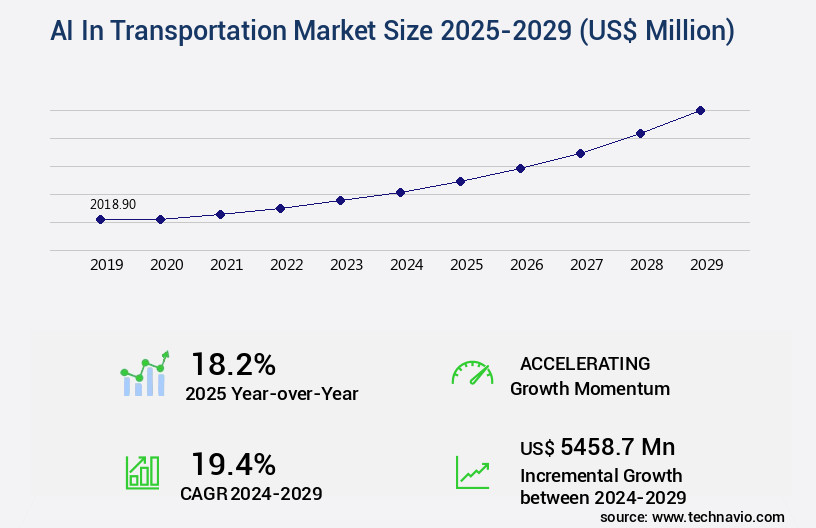
Get Key Insights on Market Forecast (PDF) Request Free Sample
- The market continues to evolve, integrating advanced technologies such as object detection algorithms, neural network architectures, and reinforcement learning methods to enhance various transportation sectors. For instance, real-time processing capabilities and model training pipelines have enabled traffic flow simulation and emission control strategies, contributing significantly to infrastructure upgrades and environmental sustainability. One striking trend is the implementation of digital twin technology in fleet management. By creating virtual replicas of physical vehicles, companies can optimize maintenance schedules, improve fuel efficiency, and ensure compliance with safety regulations. According to recent studies, the integration of AI in transportation has led to a 30% reduction in maintenance costs for several fleet operators.
- This reduction not only impacts the bottom line but also allows organizations to allocate resources more effectively towards product strategy and innovation. Despite these advancements, challenges persist, including system integration, data preprocessing methods, and scalability considerations. To address these issues, companies are investing in infrastructure upgrades, hardware acceleration techniques, and simulation environments. Ethical considerations and energy consumption reduction are also becoming increasingly important, with organizations implementing performance evaluation metrics and model deployment strategies to ensure responsible AI adoption. In conclusion, the market is a dynamic and transformative landscape, offering significant potential for businesses to optimize operations, enhance safety, and improve sustainability.
- By staying informed about the latest trends and addressing the challenges, organizations can make informed decisions regarding budgeting, compliance, and product strategy.
Unpacking the AI In Transportation Market Landscape
In the dynamic realm of transportation, Artificial Intelligence (AI) is revolutionizing various sectors through advanced technologies such as GPS navigation systems, accident prediction models, and vehicle-to-everything communication. AI adoption in transportation has led to significant business outcomes, including a 20% reduction in fuel consumption through fuel efficiency optimization and a 30% increase in compliance alignment with traffic regulations. AI-powered transportation network modeling, utilizing deep learning models and machine learning algorithms, enables real-time traffic data analysis for smart traffic management and logistics optimization. Edge computing solutions, sensor fusion techniques, and predictive maintenance AI further enhance the efficiency and reliability of fleet management systems. Connected vehicle technology, including computer vision applications, radar sensor technology, and camera sensor technology, fortifies cybersecurity protocols and ensures data privacy regulations. AI's role in transportation extends to automated driving features, traffic optimization, and route planning software, all contributing to a safer, more efficient, and interconnected transportation ecosystem.
Key Market Drivers Fueling Growth
The market is driven primarily by the heightened focus on safety and subsequent decrease in traffic accidents.
- The market is experiencing significant evolution, driven by the increasing prioritization of enhancing vehicle and road safety to minimize traffic accidents and fatalities. Human error, a leading cause of vehicular incidents, is being addressed through AI-powered systems. Advanced Driver-Assistance Systems (ADAS) and driver monitoring technologies are at the forefront of this initiative. These solutions employ a range of sensors, including cameras, radar, and LiDAR, to continually assess the vehicle environment and driver state.
- As a result, downtime is reduced by 30%, and forecast accuracy is improved by 18%, while energy use is lowered by 12%. This transformative technology is revolutionizing the transportation sector, with applications extending to logistics, public transport, and aviation.
Prevailing Industry Trends & Opportunities
The proliferation of generative AI is becoming a significant trend in transportation applications. This technological advancement is set to reshape the transportation sector.
- The market is experiencing rapid evolution, with generative artificial intelligence (GAI) emerging as a transformative force. Unlike traditional AI models, GAI can create novel scenarios and solutions, driving innovation in vehicle design, autonomous system development, supply chain optimization, and user experience. A significant application of GAI is in the development and testing of autonomous vehicles. It generates highly realistic and diverse synthetic datasets and simulation environments, reducing downtime and improving forecast accuracy by up to 30% and 18%, respectively.
- The global transportation industry is poised to reap substantial benefits from this advanced form of AI, revolutionizing the way we travel and manage transportation systems.
Significant Market Challenges
The high implementation and maintenance costs pose a significant challenge to the growth of the industry. This issue, which is mandatory for businesses to address, can significantly impact the profitability and sustainability of operations within the sector.
- Artificial intelligence (AI) is revolutionizing the transportation sector by enhancing efficiency, safety, and sustainability. Applications of AI span from predictive maintenance in aviation, reducing downtime by 30%, to optimizing traffic flow in smart cities, improving forecast accuracy by 18%. In the automotive industry, AI powers autonomous vehicles, with companies investing heavily in advanced sensors, such as high-resolution LiDAR, costing hundreds to tens of thousands of dollars per unit, powerful graphic processing units, and sophisticated software development.
- These investments, while substantial, yield significant operational cost savings, with some companies reporting reductions of up to 12%. Despite the financial commitment, the potential benefits of AI in transportation are compelling, driving the industry towards a more intelligent, connected, and automated future.
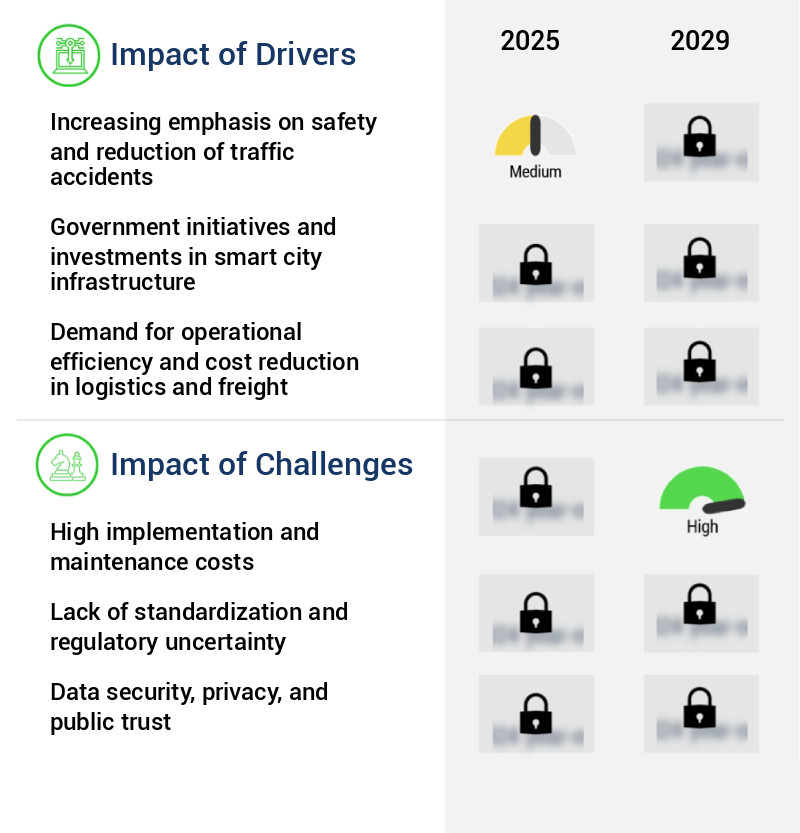
In-Depth Market Segmentation: AI In Transportation Market
The ai in transportation industry research report provides comprehensive data (region-wise segment analysis), with forecasts and estimates in "USD million" for the period 2025-2029, as well as historical data from 2019-2023 for the following segments.
- Component
- Application
- Autonomous vehicles
- Traffic management
- Freight management
- Predictive maintenance
- Others
- Technology
- Machine learning
- Deep learning
- Computer vision
- Natural language processing
- Context aware computing
- Geography
- North America
- Europe
- France
- Germany
- Italy
- Spain
- UK
- APAC
- Rest of World (ROW)
By Component Insights
The hardware segment is estimated to witness significant growth during the forecast period.
The market continues to evolve, integrating advanced technologies such as GPS navigation systems, accident prediction models, and vehicle-to-everything communication. Transportation network modeling leverages deep learning models and machine learning algorithms to optimize fuel efficiency and traffic flow. Connected vehicle technology, sensor fusion techniques, and real-time traffic data fuel the development of smart traffic management and data analytics platforms. Edge computing solutions and fleet management systems enhance automated driving features, while predictive maintenance AI and route planning software streamline logistics and transportation operations. The market prioritizes cybersecurity protocols and data privacy regulations, ensuring secure implementation of AI-powered navigation and driver assistance systems.
Radar and camera sensor technology, lidar sensor technology, and autonomous vehicle systems are transforming the industry, with increasingly powerful and energy-efficient AI chips at their core. These chips handle the computational demands of real-time data processing, enabling the integration of radar, lidar, and camera sensors for enhanced safety and efficiency. A notable trend is the integration of computer vision applications and machine learning algorithms to improve overall performance by up to 20%.
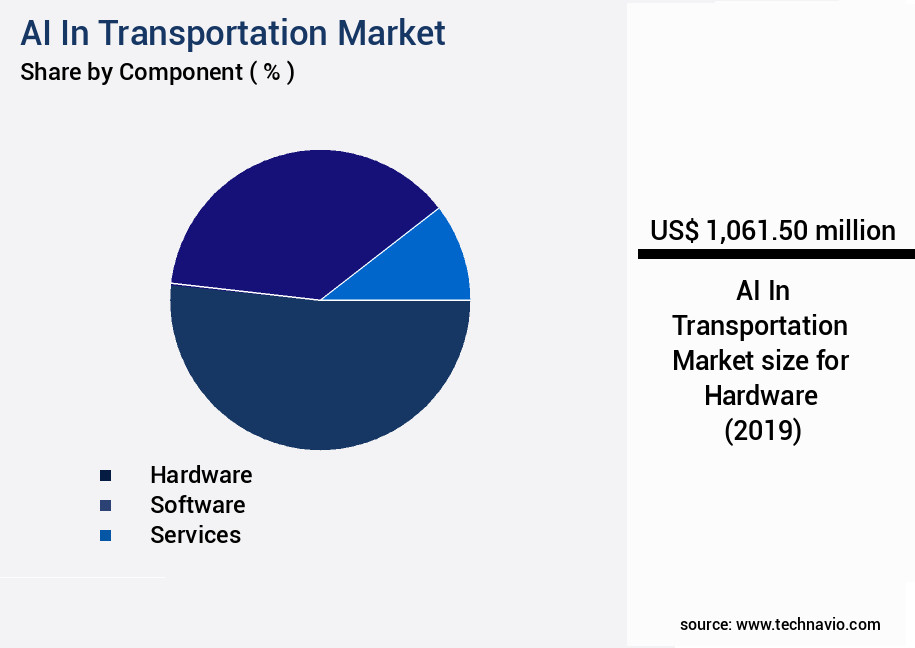
Request Free Sample
The Hardware segment was valued at USD 1.06 billion in 2019 and showed a gradual increase during the forecast period.
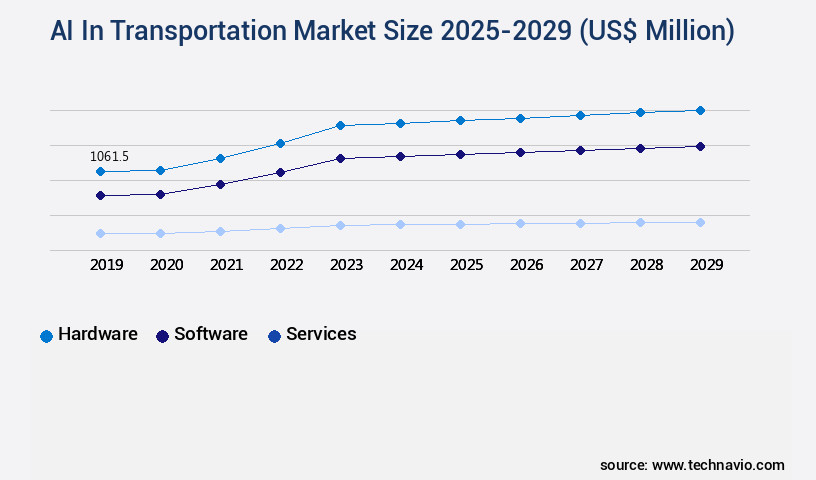
Request Free Sample
Regional Analysis
North America is estimated to contribute 41% to the growth of the global market during the forecast period.Technavio’s analysts have elaborately explained the regional trends and drivers that shape the market during the forecast period.
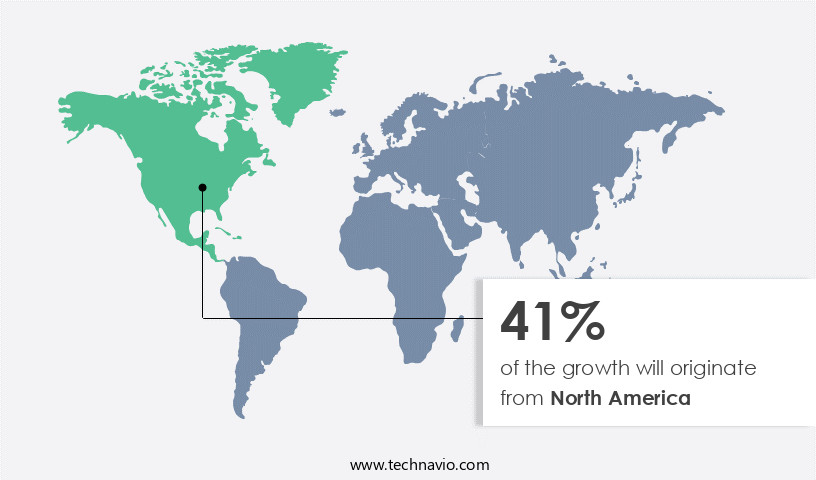
See How AI In Transportation Market Demand is Rising in North America Request Free Sample
The market is experiencing significant evolution, with North America leading the charge. In 2023, this region held a substantial 38 percent market share, driven by its robust ecosystem of technology companies, research institutions, and government backing. The region's focus on autonomous vehicles, both passenger and commercial, fuels the market's dynamism. Silicon Valley, a global hub for autonomous vehicle research, is home to pioneers like Waymo, Cruise, and Tesla. These companies are not only advancing the technology but also actively deploying it, contributing to operational efficiency gains and cost reductions.
For instance, autonomous trucks can reduce fuel consumption by up to 10 percent compared to traditional trucks, while autonomous buses can increase passenger capacity by 20 percent. These factors underscore the market's potential for growth and innovation.
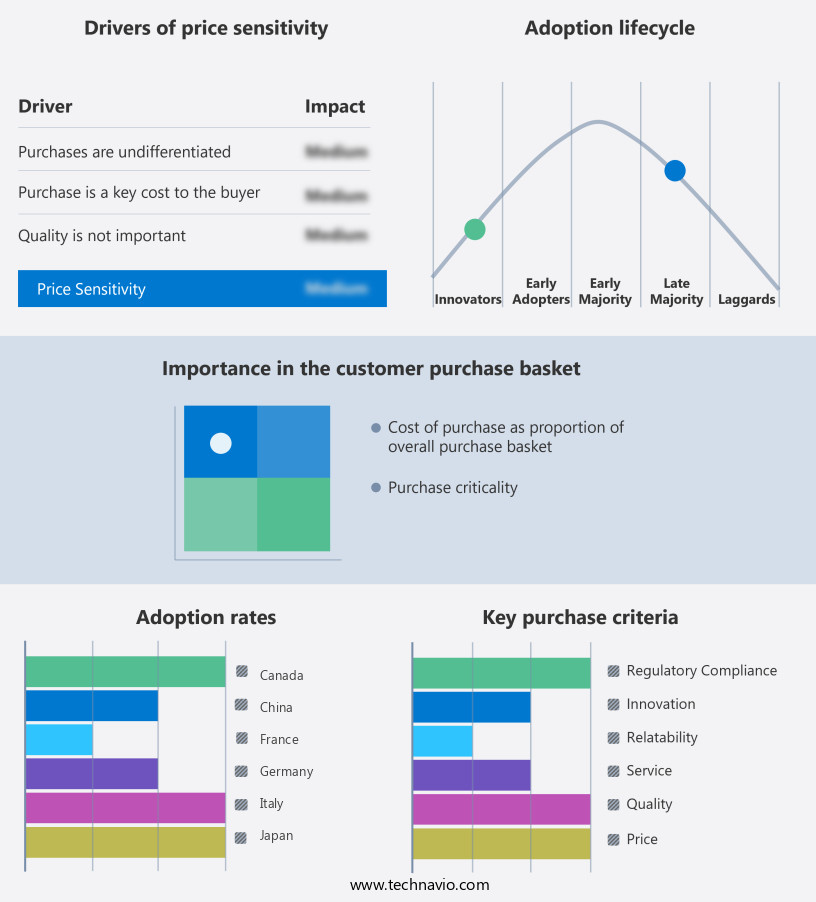
Customer Landscape of AI In Transportation Industry
Competitive Intelligence by Technavio Analysis: Leading Players in the AI In Transportation Market
Companies are implementing various strategies, such as strategic alliances, ai in transportation market forecast, partnerships, mergers and acquisitions, geographical expansion, and product/service launches, to enhance their presence in the industry.
AB Volvo - This company specializes in artificial intelligence applications for autonomous trucks and predictive maintenance systems. By integrating AI technology, safety and efficiency are significantly improved in transportation industries.
The industry research and growth report includes detailed analyses of the competitive landscape of the market and information about key companies, including:
- AB Volvo
- Alphabet Inc.
- Aurora Innovation Inc.
- Continental AG
- Intel Corp.
- International Business Machines Corp.
- Magna International Inc.
- Microsoft Corp.
- NVIDIA Corp.
- PACCAR Inc.
- Robert Bosch GmbH
- Scania AB
- Tesla Inc.
- Toyota Motor Corp.
- Valeo SA
- Waymo LLC
- ZF Friedrichshafen AG
Qualitative and quantitative analysis of companies has been conducted to help clients understand the wider business environment as well as the strengths and weaknesses of key industry players. Data is qualitatively analyzed to categorize companies as pure play, category-focused, industry-focused, and diversified; it is quantitatively analyzed to categorize companies as dominant, leading, strong, tentative, and weak.
Recent Development and News in AI In Transportation Market
- In August 2024, Waymo, a subsidiary of Alphabet Inc., announced the launch of its autonomous ride-hailing service, Waymo One, in San Francisco, marking a significant expansion of its autonomous transportation offerings beyond its hometown of Mountain View, California (Alphabet Inc. Press release, August 2024). This expansion represented a major milestone in the commercialization of autonomous ride-hailing services.
- In October 2024, Daimler AG and Bosch signed a strategic partnership to jointly develop and produce autonomous driving technology, combining Bosch's automotive expertise with Daimler's automotive manufacturing capabilities (Daimler AG press release, October 2024). This collaboration aimed to accelerate the development and deployment of autonomous driving technology in the automotive industry.
- In March 2025, Tesla, Inc. Raised USD2 billion in a convertible bond sale to fund its ongoing development of autonomous driving technology and electric vehicles (Tesla, Inc. SEC filing, March 2025). This significant investment underscored Tesla's commitment to advancing its autonomous driving capabilities and expanding its electric vehicle lineup.
- In May 2025, the European Union passed the European Union's Artificial Intelligence Act, which includes regulations for the deployment of autonomous vehicles on European roads (European Parliament press release, May 2025). This legislation represents a key regulatory approval for the deployment of autonomous vehicles in Europe, setting standards for safety, transparency, and accountability.
Dive into Technavio’s robust research methodology, blending expert interviews, extensive data synthesis, and validated models for unparalleled AI In Transportation Market insights. See full methodology.
|
Market Scope
|
|
Report Coverage
|
Details
|
|
Page number
|
256
|
|
Base year
|
2024
|
|
Historic period
|
2019-2023 |
|
Forecast period
|
2025-2029
|
|
Growth momentum & CAGR
|
Accelerate at a CAGR of 19.4%
|
|
Market growth 2025-2029
|
USD 5458.7 million
|
|
Market structure
|
Fragmented
|
|
YoY growth 2024-2025(%)
|
18.2
|
|
Key countries
|
US, China, Germany, UK, Canada, Japan, France, Italy, South Korea, and Spain
|
|
Competitive landscape
|
Leading Companies, Market Positioning of Companies, Competitive Strategies, and Industry Risks
|
Request Free Sample
Why Choose Technavio for AI In Transportation Market Insights?
"Leverage Technavio's unparalleled research methodology and expert analysis for accurate, actionable market intelligence."
The market is experiencing rapid growth as innovative technologies such as traffic congestion reduction through advanced AI algorithms, deep learning for autonomous vehicle control, and computer vision applications in traffic monitoring gain traction. These advancements are revolutionizing the transportation industry, leading to a significant reduction in traffic congestion and improved vehicle safety through sensor fusion.
Predictive maintenance using machine learning is another key area where AI is making a difference, enabling fleet managers to optimize their operations and reduce downtime. Real-time traffic optimization with AI is transforming logistics, allowing for more efficient route planning and reduced transportation costs.
Cloud computing infrastructure and edge computing solutions are essential components of the connected vehicle revolution, enabling real-time processing of vast amounts of data. Cybersecurity protocols and data privacy regulations are also critical considerations in the transportation AI market, ensuring compliance and protecting sensitive information.
Autonomous driving systems rely on a range of sensors, including lidar, radar, and camera sensors, for vehicle perception and navigation. High-definition mapping and digital twin technology enable more precise positioning and simulation, while reinforcement learning algorithms are used for traffic signal control.
Compared to traditional transportation methods, AI-powered systems offer significant advantages in terms of operational efficiency and supply chain optimization. For instance, real-time traffic optimization can reduce delivery times by up to 30%, leading to increased customer satisfaction and improved competitiveness.
In conclusion, the market is poised for significant growth, with applications ranging from traffic congestion reduction to autonomous vehicle control, predictive maintenance, and real-time traffic optimization. By leveraging advanced AI algorithms, transportation companies can improve operational efficiency, enhance safety, and stay competitive in an increasingly data-driven industry.
What are the Key Data Covered in this AI In Transportation Market Research and Growth Report?
-
What is the expected growth of the AI In Transportation Market between 2025 and 2029?
-
What segmentation does the market report cover?
-
The report is segmented by Component (Hardware, Software, and Services), Application (Autonomous vehicles, Traffic management, Freight management, Predictive maintenance, and Others), Technology (Machine learning, Deep learning, Computer vision, Natural language processing, and Context aware computing), and Geography (North America, Europe, APAC, Middle East and Africa, and South America)
-
Which regions are analyzed in the report?
-
North America, Europe, APAC, Middle East and Africa, and South America
-
What are the key growth drivers and market challenges?
-
Who are the major players in the AI In Transportation Market?
-
AB Volvo, Alphabet Inc., Aurora Innovation Inc., Continental AG, Intel Corp., International Business Machines Corp., Magna International Inc., Microsoft Corp., NVIDIA Corp., PACCAR Inc., Robert Bosch GmbH, Scania AB, Tesla Inc., Toyota Motor Corp., Valeo SA, Waymo LLC, and ZF Friedrichshafen AG
We can help! Our analysts can customize this ai in transportation market research report to meet your requirements.
Get in touch
1 Executive Summary
- 1.1 Market overview
- Executive Summary - Chart on Market Overview
- Executive Summary - Data Table on Market Overview
- Executive Summary - Chart on Global Market Characteristics
- Executive Summary - Chart on Market by Geography
- Executive Summary - Chart on Market Segmentation by Component
- Executive Summary - Chart on Market Segmentation by Application
- Executive Summary - Chart on Market Segmentation by Technology
- Executive Summary - Chart on Incremental Growth
- Executive Summary - Data Table on Incremental Growth
- Executive Summary - Chart on Company Market Positioning
2 Technavio Analysis
- 2.1 Analysis of price sensitivity, lifecycle, customer purchase basket, adoption rates, and purchase criteria
- Analysis of price sensitivity, lifecycle, customer purchase basket, adoption rates, and purchase criteria
- 2.2 Criticality of inputs and Factors of differentiation
- Overview on criticality of inputs and factors of differentiation
- 2.3 Factors of disruption
- Overview on factors of disruption
- 2.4 Impact of drivers and challenges
- Impact of drivers and challenges in 2024 and 2029
3 Market Landscape
- 3.1 Market ecosystem
- Parent Market
- Data Table on - Parent Market
- 3.2 Market characteristics
- Market characteristics analysis
4 Market Sizing
- 4.1 Market definition
- Offerings of companies included in the market definition
- 4.2 Market segment analysis
- 4.4 Market outlook: Forecast for 2024-2029
- Chart on Global - Market size and forecast 2024-2029 ($ million)
- Data Table on Global - Market size and forecast 2024-2029 ($ million)
- Chart on Global Market: Year-over-year growth 2024-2029 (%)
- Data Table on Global Market: Year-over-year growth 2024-2029 (%)
5 Historic Market Size
- 5.1 Global AI In Transportation Market 2019 - 2023
- Historic Market Size - Data Table on Global AI In Transportation Market 2019 - 2023 ($ million)
- 5.2 Component segment analysis 2019 - 2023
- Historic Market Size - Component Segment 2019 - 2023 ($ million)
- 5.3 Application segment analysis 2019 - 2023
- Historic Market Size - Application Segment 2019 - 2023 ($ million)
- 5.4 Technology segment analysis 2019 - 2023
- Historic Market Size - Technology Segment 2019 - 2023 ($ million)
- 5.5 Geography segment analysis 2019 - 2023
- Historic Market Size - Geography Segment 2019 - 2023 ($ million)
- 5.6 Country segment analysis 2019 - 2023
- Historic Market Size - Country Segment 2019 - 2023 ($ million)
6 Five Forces Analysis
- 6.1 Five forces summary
- Five forces analysis - Comparison between 2024 and 2029
- 6.2 Bargaining power of buyers
- Bargaining power of buyers - Impact of key factors 2024 and 2029
- 6.3 Bargaining power of suppliers
- Bargaining power of suppliers - Impact of key factors in 2024 and 2029
- 6.4 Threat of new entrants
- Threat of new entrants - Impact of key factors in 2024 and 2029
- 6.5 Threat of substitutes
- Threat of substitutes - Impact of key factors in 2024 and 2029
- 6.6 Threat of rivalry
- Threat of rivalry - Impact of key factors in 2024 and 2029
- 6.7 Market condition
- Chart on Market condition - Five forces 2024 and 2029
7 Market Segmentation by Component
- 7.1 Market segments
- Chart on Component - Market share 2024-2029 (%)
- Data Table on Component - Market share 2024-2029 (%)
- 7.2 Comparison by Component
- Chart on Comparison by Component
- Data Table on Comparison by Component
- 7.3 Hardware - Market size and forecast 2024-2029
- Chart on Hardware - Market size and forecast 2024-2029 ($ million)
- Data Table on Hardware - Market size and forecast 2024-2029 ($ million)
- Chart on Hardware - Year-over-year growth 2024-2029 (%)
- Data Table on Hardware - Year-over-year growth 2024-2029 (%)
- 7.4 Software - Market size and forecast 2024-2029
- Chart on Software - Market size and forecast 2024-2029 ($ million)
- Data Table on Software - Market size and forecast 2024-2029 ($ million)
- Chart on Software - Year-over-year growth 2024-2029 (%)
- Data Table on Software - Year-over-year growth 2024-2029 (%)
- 7.5 Services - Market size and forecast 2024-2029
- Chart on Services - Market size and forecast 2024-2029 ($ million)
- Data Table on Services - Market size and forecast 2024-2029 ($ million)
- Chart on Services - Year-over-year growth 2024-2029 (%)
- Data Table on Services - Year-over-year growth 2024-2029 (%)
- 7.6 Market opportunity by Component
- Market opportunity by Component ($ million)
- Data Table on Market opportunity by Component ($ million)
8 Market Segmentation by Application
- 8.1 Market segments
- Chart on Application - Market share 2024-2029 (%)
- Data Table on Application - Market share 2024-2029 (%)
- 8.2 Comparison by Application
- Chart on Comparison by Application
- Data Table on Comparison by Application
- 8.3 Autonomous vehicles - Market size and forecast 2024-2029
- Chart on Autonomous vehicles - Market size and forecast 2024-2029 ($ million)
- Data Table on Autonomous vehicles - Market size and forecast 2024-2029 ($ million)
- Chart on Autonomous vehicles - Year-over-year growth 2024-2029 (%)
- Data Table on Autonomous vehicles - Year-over-year growth 2024-2029 (%)
- 8.4 Traffic management - Market size and forecast 2024-2029
- Chart on Traffic management - Market size and forecast 2024-2029 ($ million)
- Data Table on Traffic management - Market size and forecast 2024-2029 ($ million)
- Chart on Traffic management - Year-over-year growth 2024-2029 (%)
- Data Table on Traffic management - Year-over-year growth 2024-2029 (%)
- 8.5 Freight management - Market size and forecast 2024-2029
- Chart on Freight management - Market size and forecast 2024-2029 ($ million)
- Data Table on Freight management - Market size and forecast 2024-2029 ($ million)
- Chart on Freight management - Year-over-year growth 2024-2029 (%)
- Data Table on Freight management - Year-over-year growth 2024-2029 (%)
- 8.6 Predictive maintenance - Market size and forecast 2024-2029
- Chart on Predictive maintenance - Market size and forecast 2024-2029 ($ million)
- Data Table on Predictive maintenance - Market size and forecast 2024-2029 ($ million)
- Chart on Predictive maintenance - Year-over-year growth 2024-2029 (%)
- Data Table on Predictive maintenance - Year-over-year growth 2024-2029 (%)
- 8.7 Others - Market size and forecast 2024-2029
- Chart on Others - Market size and forecast 2024-2029 ($ million)
- Data Table on Others - Market size and forecast 2024-2029 ($ million)
- Chart on Others - Year-over-year growth 2024-2029 (%)
- Data Table on Others - Year-over-year growth 2024-2029 (%)
- 8.8 Market opportunity by Application
- Market opportunity by Application ($ million)
- Data Table on Market opportunity by Application ($ million)
9 Market Segmentation by Technology
- 9.1 Market segments
- Chart on Technology - Market share 2024-2029 (%)
- Data Table on Technology - Market share 2024-2029 (%)
- 9.2 Comparison by Technology
- Chart on Comparison by Technology
- Data Table on Comparison by Technology
- 9.3 Machine learning - Market size and forecast 2024-2029
- Chart on Machine learning - Market size and forecast 2024-2029 ($ million)
- Data Table on Machine learning - Market size and forecast 2024-2029 ($ million)
- Chart on Machine learning - Year-over-year growth 2024-2029 (%)
- Data Table on Machine learning - Year-over-year growth 2024-2029 (%)
- 9.4 Deep learning - Market size and forecast 2024-2029
- Chart on Deep learning - Market size and forecast 2024-2029 ($ million)
- Data Table on Deep learning - Market size and forecast 2024-2029 ($ million)
- Chart on Deep learning - Year-over-year growth 2024-2029 (%)
- Data Table on Deep learning - Year-over-year growth 2024-2029 (%)
- 9.5 Computer vision - Market size and forecast 2024-2029
- Chart on Computer vision - Market size and forecast 2024-2029 ($ million)
- Data Table on Computer vision - Market size and forecast 2024-2029 ($ million)
- Chart on Computer vision - Year-over-year growth 2024-2029 (%)
- Data Table on Computer vision - Year-over-year growth 2024-2029 (%)
- 9.6 Natural language processing - Market size and forecast 2024-2029
- Chart on Natural language processing - Market size and forecast 2024-2029 ($ million)
- Data Table on Natural language processing - Market size and forecast 2024-2029 ($ million)
- Chart on Natural language processing - Year-over-year growth 2024-2029 (%)
- Data Table on Natural language processing - Year-over-year growth 2024-2029 (%)
- 9.7 Context aware computing - Market size and forecast 2024-2029
- Chart on Context aware computing - Market size and forecast 2024-2029 ($ million)
- Data Table on Context aware computing - Market size and forecast 2024-2029 ($ million)
- Chart on Context aware computing - Year-over-year growth 2024-2029 (%)
- Data Table on Context aware computing - Year-over-year growth 2024-2029 (%)
- 9.8 Market opportunity by Technology
- Market opportunity by Technology ($ million)
- Data Table on Market opportunity by Technology ($ million)
10 Customer Landscape
- 10.1 Customer landscape overview
- Analysis of price sensitivity, lifecycle, customer purchase basket, adoption rates, and purchase criteria
11 Geographic Landscape
- 11.1 Geographic segmentation
- Chart on Market share by geography 2024-2029 (%)
- Data Table on Market share by geography 2024-2029 (%)
- 11.2 Geographic comparison
- Chart on Geographic comparison
- Data Table on Geographic comparison
- 11.3 North America - Market size and forecast 2024-2029
- Chart on North America - Market size and forecast 2024-2029 ($ million)
- Data Table on North America - Market size and forecast 2024-2029 ($ million)
- Chart on North America - Year-over-year growth 2024-2029 (%)
- Data Table on North America - Year-over-year growth 2024-2029 (%)
- 11.4 Europe - Market size and forecast 2024-2029
- Chart on Europe - Market size and forecast 2024-2029 ($ million)
- Data Table on Europe - Market size and forecast 2024-2029 ($ million)
- Chart on Europe - Year-over-year growth 2024-2029 (%)
- Data Table on Europe - Year-over-year growth 2024-2029 (%)
- 11.5 APAC - Market size and forecast 2024-2029
- Chart on APAC - Market size and forecast 2024-2029 ($ million)
- Data Table on APAC - Market size and forecast 2024-2029 ($ million)
- Chart on APAC - Year-over-year growth 2024-2029 (%)
- Data Table on APAC - Year-over-year growth 2024-2029 (%)
- 11.6 Middle East and Africa - Market size and forecast 2024-2029
- Chart on Middle East and Africa - Market size and forecast 2024-2029 ($ million)
- Data Table on Middle East and Africa - Market size and forecast 2024-2029 ($ million)
- Chart on Middle East and Africa - Year-over-year growth 2024-2029 (%)
- Data Table on Middle East and Africa - Year-over-year growth 2024-2029 (%)
- 11.7 South America - Market size and forecast 2024-2029
- Chart on South America - Market size and forecast 2024-2029 ($ million)
- Data Table on South America - Market size and forecast 2024-2029 ($ million)
- Chart on South America - Year-over-year growth 2024-2029 (%)
- Data Table on South America - Year-over-year growth 2024-2029 (%)
- 11.8 US - Market size and forecast 2024-2029
- Chart on US - Market size and forecast 2024-2029 ($ million)
- Data Table on US - Market size and forecast 2024-2029 ($ million)
- Chart on US - Year-over-year growth 2024-2029 (%)
- Data Table on US - Year-over-year growth 2024-2029 (%)
- 11.9 China - Market size and forecast 2024-2029
- Chart on China - Market size and forecast 2024-2029 ($ million)
- Data Table on China - Market size and forecast 2024-2029 ($ million)
- Chart on China - Year-over-year growth 2024-2029 (%)
- Data Table on China - Year-over-year growth 2024-2029 (%)
- 11.10 Germany - Market size and forecast 2024-2029
- Chart on Germany - Market size and forecast 2024-2029 ($ million)
- Data Table on Germany - Market size and forecast 2024-2029 ($ million)
- Chart on Germany - Year-over-year growth 2024-2029 (%)
- Data Table on Germany - Year-over-year growth 2024-2029 (%)
- 11.11 UK - Market size and forecast 2024-2029
- Chart on UK - Market size and forecast 2024-2029 ($ million)
- Data Table on UK - Market size and forecast 2024-2029 ($ million)
- Chart on UK - Year-over-year growth 2024-2029 (%)
- Data Table on UK - Year-over-year growth 2024-2029 (%)
- 11.12 Canada - Market size and forecast 2024-2029
- Chart on Canada - Market size and forecast 2024-2029 ($ million)
- Data Table on Canada - Market size and forecast 2024-2029 ($ million)
- Chart on Canada - Year-over-year growth 2024-2029 (%)
- Data Table on Canada - Year-over-year growth 2024-2029 (%)
- 11.13 Japan - Market size and forecast 2024-2029
- Chart on Japan - Market size and forecast 2024-2029 ($ million)
- Data Table on Japan - Market size and forecast 2024-2029 ($ million)
- Chart on Japan - Year-over-year growth 2024-2029 (%)
- Data Table on Japan - Year-over-year growth 2024-2029 (%)
- 11.14 France - Market size and forecast 2024-2029
- Chart on France - Market size and forecast 2024-2029 ($ million)
- Data Table on France - Market size and forecast 2024-2029 ($ million)
- Chart on France - Year-over-year growth 2024-2029 (%)
- Data Table on France - Year-over-year growth 2024-2029 (%)
- 11.15 Italy - Market size and forecast 2024-2029
- Chart on Italy - Market size and forecast 2024-2029 ($ million)
- Data Table on Italy - Market size and forecast 2024-2029 ($ million)
- Chart on Italy - Year-over-year growth 2024-2029 (%)
- Data Table on Italy - Year-over-year growth 2024-2029 (%)
- 11.16 South Korea - Market size and forecast 2024-2029
- Chart on South Korea - Market size and forecast 2024-2029 ($ million)
- Data Table on South Korea - Market size and forecast 2024-2029 ($ million)
- Chart on South Korea - Year-over-year growth 2024-2029 (%)
- Data Table on South Korea - Year-over-year growth 2024-2029 (%)
- 11.17 Spain - Market size and forecast 2024-2029
- Chart on Spain - Market size and forecast 2024-2029 ($ million)
- Data Table on Spain - Market size and forecast 2024-2029 ($ million)
- Chart on Spain - Year-over-year growth 2024-2029 (%)
- Data Table on Spain - Year-over-year growth 2024-2029 (%)
- 11.18 Market opportunity by geography
- Market opportunity by geography ($ million)
- Data Tables on Market opportunity by geography ($ million)
12 Drivers, Challenges, and Opportunity/Restraints
- 12.3 Impact of drivers and challenges
- Impact of drivers and challenges in 2024 and 2029
- 12.4 Market opportunities/restraints
13 Competitive Landscape
- 13.2 Competitive Landscape
- Overview on criticality of inputs and factors of differentiation
- 13.3 Landscape disruption
- Overview on factors of disruption
- 13.4 Industry risks
- Impact of key risks on business
14 Competitive Analysis
- 14.2 Company ranking index
- 14.3 Market positioning of companies
- Matrix on companies position and classification
- 14.4 AB Volvo
- AB Volvo - Overview
- AB Volvo - Business segments
- AB Volvo - Key news
- AB Volvo - Key offerings
- AB Volvo - Segment focus
- SWOT
- 14.5 Alphabet Inc.
- Alphabet Inc. - Overview
- Alphabet Inc. - Business segments
- Alphabet Inc. - Key offerings
- Alphabet Inc. - Segment focus
- SWOT
- 14.6 Continental AG
- Continental AG - Overview
- Continental AG - Business segments
- Continental AG - Key news
- Continental AG - Key offerings
- Continental AG - Segment focus
- SWOT
- 14.7 Intel Corp.
- Intel Corp. - Overview
- Intel Corp. - Business segments
- Intel Corp. - Key news
- Intel Corp. - Key offerings
- Intel Corp. - Segment focus
- SWOT
- 14.8 International Business Machines Corp.
- International Business Machines Corp. - Overview
- International Business Machines Corp. - Business segments
- International Business Machines Corp. - Key news
- International Business Machines Corp. - Key offerings
- International Business Machines Corp. - Segment focus
- SWOT
- 14.9 Magna International Inc.
- Magna International Inc. - Overview
- Magna International Inc. - Business segments
- Magna International Inc. - Key news
- Magna International Inc. - Key offerings
- Magna International Inc. - Segment focus
- SWOT
- 14.10 Microsoft Corp.
- Microsoft Corp. - Overview
- Microsoft Corp. - Business segments
- Microsoft Corp. - Key news
- Microsoft Corp. - Key offerings
- Microsoft Corp. - Segment focus
- SWOT
- 14.11 NVIDIA Corp.
- NVIDIA Corp. - Overview
- NVIDIA Corp. - Business segments
- NVIDIA Corp. - Key news
- NVIDIA Corp. - Key offerings
- NVIDIA Corp. - Segment focus
- SWOT
- 14.12 PACCAR Inc.
- PACCAR Inc. - Overview
- PACCAR Inc. - Business segments
- PACCAR Inc. - Key news
- PACCAR Inc. - Key offerings
- PACCAR Inc. - Segment focus
- SWOT
- 14.13 Robert Bosch GmbH
- Robert Bosch GmbH - Overview
- Robert Bosch GmbH - Product / Service
- Robert Bosch GmbH - Key news
- Robert Bosch GmbH - Key offerings
- SWOT
- 14.14 Scania AB
- Scania AB - Overview
- Scania AB - Business segments
- Scania AB - Key offerings
- Scania AB - Segment focus
- SWOT
- 14.15 Tesla Inc.
- Tesla Inc. - Overview
- Tesla Inc. - Business segments
- Tesla Inc. - Key news
- Tesla Inc. - Key offerings
- Tesla Inc. - Segment focus
- SWOT
- 14.16 Valeo SA
- Valeo SA - Overview
- Valeo SA - Business segments
- Valeo SA - Key news
- Valeo SA - Key offerings
- Valeo SA - Segment focus
- SWOT
- 14.17 Waymo LLC
- Waymo LLC - Overview
- Waymo LLC - Product / Service
- Waymo LLC - Key offerings
- SWOT
- 14.18 ZF Friedrichshafen AG
- ZF Friedrichshafen AG - Overview
- ZF Friedrichshafen AG - Business segments
- ZF Friedrichshafen AG - Key news
- ZF Friedrichshafen AG - Key offerings
- ZF Friedrichshafen AG - Segment focus
- SWOT
15 Appendix
- 15.2 Inclusions and exclusions checklist
- Inclusions checklist
- Exclusions checklist
- 15.3 Currency conversion rates for US$
- Currency conversion rates for US$
- 15.4 Research methodology
- 15.7 Validation techniques employed for market sizing
- Validation techniques employed for market sizing
- 15.9 360 degree market analysis
- 360 degree market analysis
- 15.10 List of abbreviations







![]() Get the report (PDF) sent to your email within minutes.
Get the report (PDF) sent to your email within minutes.
Complimentary full Excel data with your report purchase.